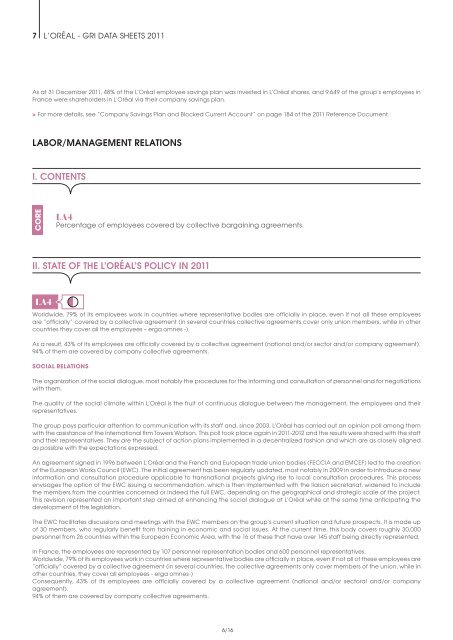Organizational Strategy - Sustainable Development - L'Oréal
Organizational Strategy - Sustainable Development - L'Oréal
Organizational Strategy - Sustainable Development - L'Oréal
Create successful ePaper yourself
Turn your PDF publications into a flip-book with our unique Google optimized e-Paper software.
7 L’OréaL - GrI DaTa SHEETS 2011<br />
as at 31 December 2011, 48% of the L’Oréal employee savings plan was invested in L’Oréal shares, and 9,649 of the group’s employees in<br />
France were shareholders in L’Oréal via their company savings plan.<br />
> For more details, see “Company Savings Plan and Blocked Current account” on page 184 of the 2011 reference Document.<br />
LABOR/MANAGEMENT RELATIONS<br />
I. CONTENTS<br />
CORE<br />
LA4<br />
Percentage of employees covered by collective bargaining agreements.<br />
II. STATE OF THE L’ORÉAL’S POLICY IN 2011<br />
LA4<br />
Worldwide, 79% of its employees work in countries where representative bodies are officially in place, even if not all these employees<br />
are “officially” covered by a collective agreement (in several countries collective agreements cover only union members, while in other<br />
countries they cover all the employees – erga omnes -).<br />
as a result, 43% of its employees are officially covered by a collective agreement (national and/or sector and/or company agreement).<br />
94% of them are covered by company collective agreements.<br />
SOCIAL RELATIONS<br />
The organization of the social dialogue, most notably the procedures for the informing and consultation of personnel and for negotiations<br />
with them.<br />
The quality of the social climate within L’Oréal is the fruit of continuous dialogue between the management, the employees and their<br />
representatives.<br />
The group pays particular attention to communication with its staff and, since 2003, L’Oréal has carried out an opinion poll among them<br />
with the assistance of the international firm Towers Watson. This poll took place again in 2011-2012 and the results were shared with the staff<br />
and their representatives. They are the subject of action plans implemented in a decentralized fashion and which are as closely aligned<br />
as possible with the expectations expressed.<br />
an agreement signed in 1996 between L’Oréal and the French and European trade union bodies (FECCIa and EMCEF) led to the creation<br />
of the European Works Council (EWC). The initial agreement has been regularly updated, most notably in 2009 in order to introduce a new<br />
information and consultation procedure applicable to transnational projects giving rise to local consultation procedures. This process<br />
envisages the option of the EWC issuing a recommendation, which is then implemented with the liaison secretariat, widened to include<br />
the members from the countries concerned or indeed the full EWC, depending on the geographical and strategic scale of the project.<br />
This revision represented an important step aimed at enhancing the social dialogue at L’Oréal while at the same time anticipating the<br />
development of the legislation.<br />
The EWC facilitates discussions and meetings with the EWC members on the group’s current situation and future prospects. It is made up<br />
of 30 members, who regularly benefit from training in economic and social issues. at the current time, this body covers roughly 30,000<br />
personnel from 26 countries within the European Economic area, with the 16 of these that have over 145 staff being directly represented.<br />
In France, the employees are represented by 107 personnel representation bodies and 600 personnel representatives.<br />
Worldwide, 79% of its employees work in countries where representative bodies are officially in place, even if not all of these employees are<br />
“officially” covered by a collective agreement (in several countries, the collective agreements only cover members of the union, while in<br />
other countries, they cover all employees - erga omnes-)<br />
Consequently, 43% of its employees are officially covered by a collective agreement (national and/or sectoral and/or company<br />
agreement).<br />
94% of them are covered by company collective agreements.<br />
6/16






